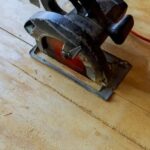Stripping dry paint from woodwork can be a daunting task, but with the right approach and techniques, it can be done effectively and efficiently. In this article, we will explore the various methods and tools needed to successfully remove dry paint from woodwork. Whether you’re dealing with acrylic, oil-based, or latex paint on your wood surfaces, understanding the challenge of removing dry paint is the first step towards achieving a clean and restored finish.
When it comes to removing dry paint from woodwork, the type of paint and finish of the wood will determine the approach you need to take. Different paints require different methods for removal, and knowing how to assess the type of paint and woodwork is crucial for successful removal. By understanding these factors, you can choose the most effective technique for your specific situation.
In this comprehensive guide, we will cover everything from the tools and materials needed for the job to preparing the work area for safe and efficient paint removal. We will also provide step-by-step instructions for different techniques to remove dry paint from woodwork.
Additionally, we will discuss how to clean and restore the woodwork after removing the paint and offer tips for preventing future paint buildup. With this information at your disposal, you’ll be equipped to tackle even the toughest paint removal challenges on your woodwork.
Assessing the Type of Paint and Woodwork
When it comes to removing dry paint from woodwork, it’s important to first assess the type of paint and finish on the wood in order to determine the best approach for removal. Different paints and finishes may require different techniques and products for successful removal without damaging the woodwork. Here are some tips for assessing the type of paint and woodwork:
- Identify the type of paint: Determine whether the dry paint is oil-based, latex, acrylic, or another type of paint. This will help you choose the right solvent or method for removal.
- Inspect the woodwork finish: Check whether the woodwork has a stained, varnished, or painted finish. Certain finishes may be more sensitive to harsh chemicals or abrasive methods, so it’s important to take this into consideration.
Once you have assessed the type of paint and woodwork, you can then proceed with choosing the appropriate method for removing the dry paint without causing damage. Keep in mind that some paints and finishes may require professional assistance if you are unsure about how to proceed.
After identifying the type of paint and finish on your woodwork, you can now move on to selecting the right tools and materials needed for effective paint removal. By understanding these key factors upfront, you’ll be better prepared to tackle the challenge of removing dry paint from your woodwork without causing any harm.
Tools and Materials Needed
When it comes to removing dry paint from woodwork, having the right tools and materials is essential for a successful outcome. The specific supplies you’ll need can vary depending on the type of paint and woodwork you’re dealing with, so it’s important to assess the situation before gathering your supplies.
If you’re working with latex or water-based paint, you’ll likely be able to remove it using a different set of tools and materials compared to oil-based paint. For latex or water-based paint removal, you may only need basic supplies such as warm soapy water, a scrub brush, and a putty knife.
On the other hand, removing oil-based paint typically requires stronger solvents such as mineral spirits or denatured alcohol, along with sandpaper for smoothing out the woodwork after paint removal.
In addition to considering the type of paint, it’s also crucial to assess the type of woodwork you’re working with. Different finishes like varnish or lacquer may react differently to certain solvents or cleaning agents, so be sure to research and select appropriate materials based on the specific characteristics of your woodwork. By taking the time to gather the right tools and materials for your particular situation, you can ensure a more efficient and effective paint removal process.
| Tools | Materials |
|---|---|
| Putty knife | Warm soapy water |
| Scrub brush | Solvents (mineral spirits or denatured alcohol) |
| Sandpaper | Protective gloves |
Preparing the Work Area
Gathering the Necessary Tools and Materials
Before starting the paint removal process, it is essential to gather the right tools and materials. This may include paint scrapers, sandpaper, chemical paint strippers, protective gloves, safety goggles, drop cloths, and ventilation equipment. Having these items on hand will make the task easier and safer.
Covering Surrounding Surfaces
To prevent accidental damage to surrounding areas, it is important to cover nearby floors, walls, and furniture with drop cloths or plastic sheeting. This will help contain any paint chips or debris that may result from the removal process.
Creating Proper Ventilation
When working with chemical paint strippers or sanding wood, proper ventilation is essential. Open windows and doors to allow fresh air to circulate through the workspace. If possible, consider using fans or exhaust systems to ensure adequate ventilation.
By taking the time to properly prepare the work area before beginning the paint removal process, you can ensure a safer and more efficient experience. This will ultimately lead to better results when removing dry paint from woodwork while minimizing any potential hazards or complications.
Techniques for Removing Dry Paint From Woodwork
Removing dry paint from woodwork can be a challenging task, but with the right techniques and tools, it is possible to restore the wood to its original state. Here are some step-by-step instructions for effectively removing dry paint from woodwork:
1. Scrape off the loose paint: Use a putty knife or scraper to gently remove any loose or flaking paint from the surface of the woodwork. Be careful not to gouge or damage the wood while doing this.
2. Apply a chemical paint remover: If scraping alone doesn’t remove all of the dry paint, consider using a chemical paint remover. Follow the manufacturer’s instructions carefully and apply the remover to the affected areas. Let it sit for the recommended amount of time before using a scraper or steel wool to remove the softened paint.
3. Sand the woodwork: Once you have removed as much of the dry paint as possible, use sandpaper to smooth out any remaining rough or uneven patches on the woodwork. Start with a coarse grit sandpaper and gradually move on to finer grits until the surface is smooth.
4. Clean the woodwork: After removing the dry paint, thoroughly clean the woodwork to remove any residue from the scraping, chemical remover, or sanding process. Use a damp cloth and mild detergent to wipe down the surface, then allow it to dry completely before moving on to restoring or refinishing.
Remember that different types of paints and finishes may require different removal techniques, so always research and test a small area before proceeding with a larger project.
It’s important to be patient and thorough when removing dry paint from woodwork in order to achieve professional-looking results without causing damage.
Whether you are dealing with latex, oil-based, or acrylic paints on your woodwork, these techniques can help you effectively remove dry paint and restore your wood surfaces back their original condition.
- Scrape off loose paint
- Apply a chemical paint remover
- Sand down any remaining patches
- Clean thoroughly
Cleaning and Restoring the Woodwork
Assessing the Condition of the Woodwork
Before starting the process of removing dry paint from woodwork, it is important to assess the condition of the wood. Check for any existing damage or imperfections that may need attention before proceeding with paint removal. This includes checking for cracks, dents, or scratches that may have been caused by previous attempts at paint removal. It’s important to address these issues before moving forward to ensure a smooth and clean surface after the paint has been removed.
Choosing the Right Cleaning Method
Depending on the type of wood and finish, different cleaning methods may be required to ensure that the woodwork is effectively restored after paint removal. For example, hardwoods and softwoods may require different cleaning techniques, as well as painted versus stained woodwork. Consider consulting with a professional if you are unsure about which cleaning method is best for your specific type of woodwork.
Applying Finishing Touches
Once the dry paint has been successfully removed from the woodwork and the surface has been cleaned, it’s important to apply any necessary finishing touches to restore its original appearance. This may include sanding and refinishing the wood, applying a fresh coat of stain or paint, or simply adding a protective sealant to preserve the wood’s natural beauty.
Taking these extra steps will not only ensure a smooth and clean surface but also enhance the overall appearance of the woodwork.
By following these steps and taking care to properly clean and restore the woodwork after removing dry paint, you can ensure that your efforts result in a beautifully rejuvenated surface without causing any damage.
Preventing Future Paint Buildup
Once you have successfully removed dry paint from your woodwork, it’s essential to take preventive measures to avoid future paint buildup. Regular maintenance and care can help preserve the natural beauty of your woodwork and save you from the hassle of having to remove paint again in the future.
One effective way to prevent future paint buildup on your woodwork is by applying a clear sealant or varnish. This protective coating can help create a barrier between the wood and potential paint spills or splatters, making it easier to clean up any accidental mess without damaging the wood underneath. Be sure to choose a sealant or varnish that is compatible with the type of wood and finish you have, and follow the manufacturer’s instructions for application.
In addition to using a protective sealant, it’s important to regularly clean and dust your woodwork to prevent any debris or dirt from becoming embedded in the surface. This simple maintenance routine can help maintain the natural luster of the wood and make it less likely for paint to adhere to it in the future. Using a soft, microfiber cloth or duster is recommended to avoid scratching or causing damage to the wood surface while cleaning.
Furthermore, being mindful of where you place wet paint cans, brushes, and other painting tools can also help prevent accidental spills and splatters on your woodwork. When working on painting projects near wood surfaces, use drop cloths or protective coverings to shield them from any potential drips or leaks. This proactive approach can go a long way in maintaining the integrity of your woodwork and prolonging its lifespan.
| Preventive Measure | Description |
|---|---|
| Apply Clear Sealant/Varnish | Create a protective barrier against paint spills |
| Regular Cleaning | Remove debris and dirt to prevent paint adherence |
| Use Protective Coverings | Shield wood surfaces during painting projects |
Conclusion
In conclusion, removing dry paint from woodwork may seem like a daunting task, but with the right approach and tools, it can be effectively accomplished. By assessing the type of paint and woodwork, gathering the necessary tools and materials, and following step-by-step techniques for paint removal, you can restore the woodwork to its original state. Additionally, taking the time to clean and restore the woodwork after paint removal is crucial in ensuring a smooth and clean surface.
It is important to remember that preventing future paint buildup on woodwork is just as critical as removing existing dry paint. Regular maintenance and care of woodwork can help avoid future challenges of having to remove dry paint. By implementing preventive measures such as using protective finishes or sealants, you can maintain the quality of your woodwork and minimize the need for frequent paint removal.
Frequently Asked Questions
How Do You Get Dried Paint Off Wood Trim?
To get dried paint off wood trim, you can start by using a scraper or putty knife to gently pry the paint off. If that doesn’t work, try using a heat gun or hairdryer to soften the paint before scraping it away.
How Do You Remove Dried Paint From Wood Without Damaging Finish?
Removing dried paint from wood without damaging the finish requires careful use of solvents or chemical paint strippers. Test a small, inconspicuous area first to ensure that the solvent won’t damage the wood finish, and then gently remove the dried paint with a soft cloth or plastic scraper.
How Do You Remove Already Dried Paint?
If you need to remove already dried paint, you can try using a commercial paint remover or solvent. Apply the product according to the manufacturer’s instructions, and use a gentle abrasive like steel wool or a plastic scraper to lift off the dried paint. Remember to protect yourself with gloves and adequate ventilation while working with chemical products.

Hi everyone! I’m a woodworker and blogger, and this is my woodworking blog. In my blog, I share tips and tricks for woodworkers of all skill levels, as well as project ideas that you can try yourself.





